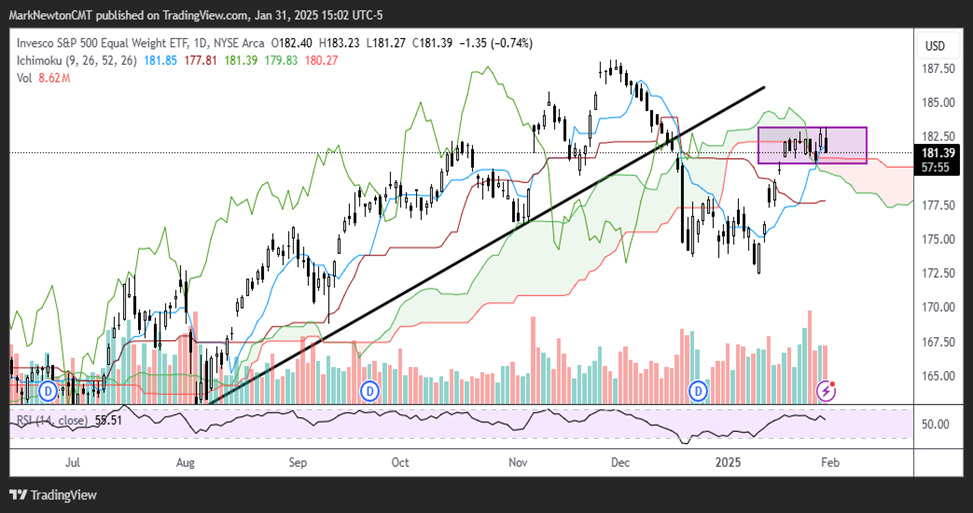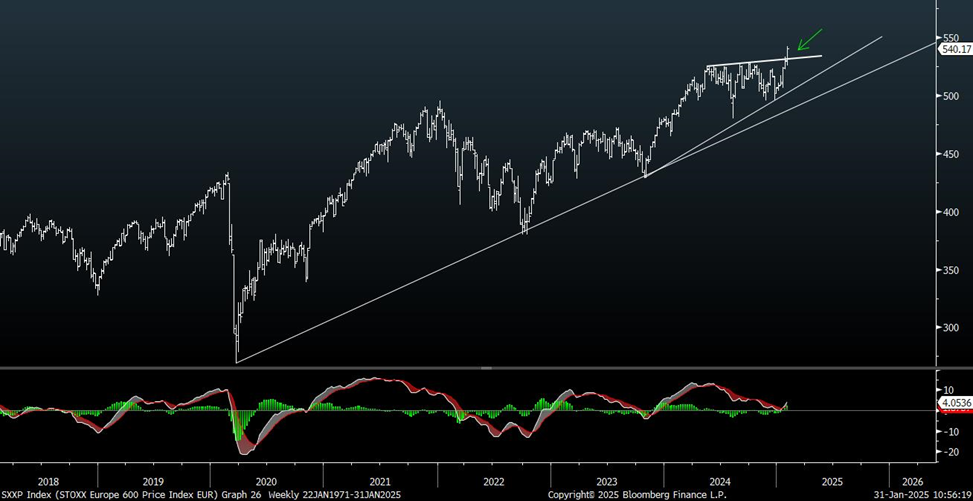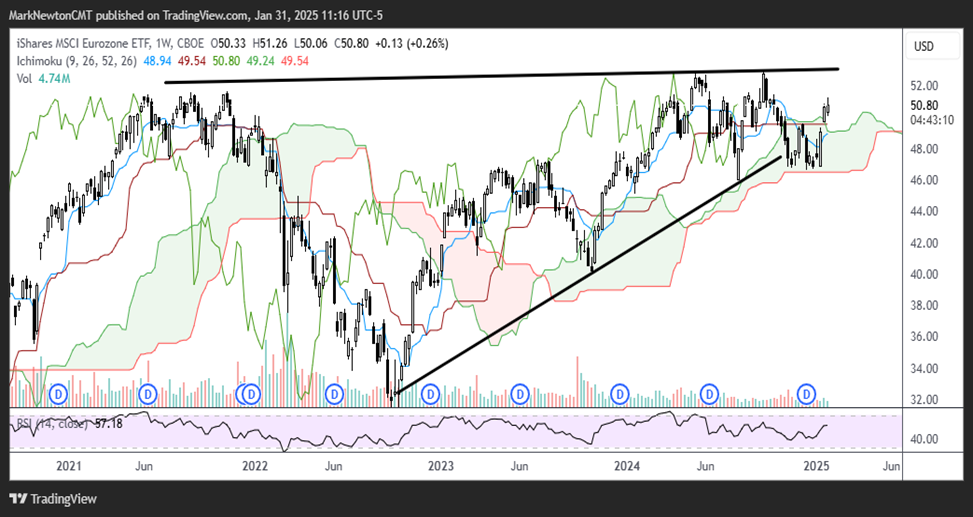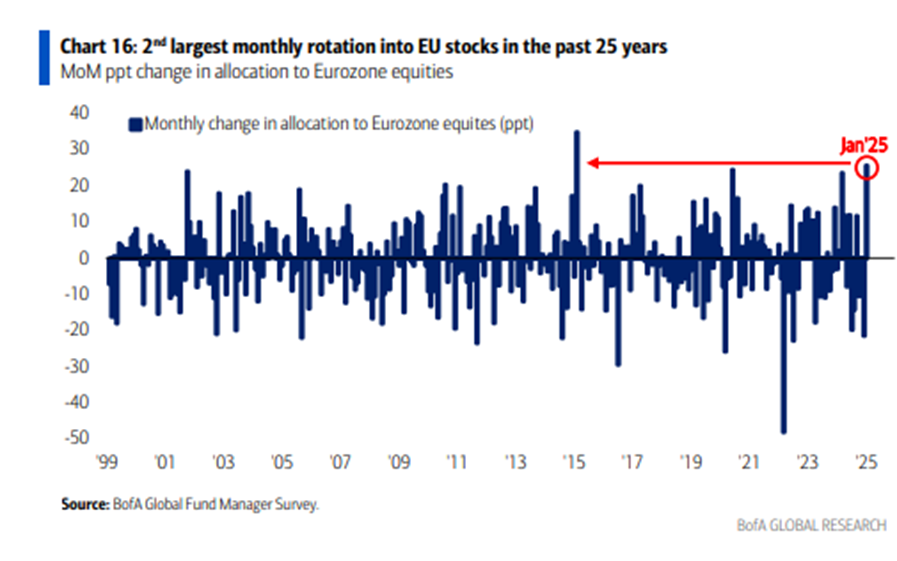SPX’s technical trend, breadth, and momentum have slowly improved over the last two weeks, showing evidence of a “Two Steps Forward, One Step Back” type trajectory. However, it’s important to reiterate that the Equal-weighted S&P has largely made no change in over a week, so there has been some stalling out after the initial bounce off the 1/13 lows. Large-Cap Technology has proven to be a short-term drag on US Equity performance compared to Europe and parts of Asia, but it’s doubtful that the “Mag 7” becomes the “Lag 7”. Overall, technically it’s premature to make the case just yet of pushback to immediate highs, given the lack of sufficient structural progress and notable weakness in some large Technology stocks. However, I believe it’s right to think that larger trends remain in excellent shape and that short-term consolidation should prove short-lived and not overly damaging to the technical structure. Weakness into February likely proves temporary and not too damaging for US Equities. In general, I suspect that downside volatility should create attractive opportunities for US Equities, but at present, SPX remains in consolidation, which cannot be called complete.
The daily chart of the Equal-weighted S&P 500 helps to illustrate the quandary for bulls and bears alike. Recent price action over the last week has made little to no net change, and RSP closed under levels that had been made last Tuesday.
Stocks like AAPL have struggled to break out, while other large-cap Tech stocks like NVDA have been slowly stabilizing but also not pushing higher. MSFT, as discussed earlier this week, has been range-bound for months and lies near the bottom of its ongoing triangle pattern. All of this suggests a picture of short-term underperformance in large-cap Technology, which has been evident as January comes to a close.
However, this doesn’t appear all that serious in the larger scheme of things. Moreover, the media’s fascination with tariffs and their possible damaging effects have not been seen in price action for Equities, which has largely been sideways and not bearish.
As shown below, the Equal-weighted S&P 500 has trended sideways since early last week, not meaningfully higher or lower.
While the negative Friday closes on stocks like AAPL and NVDA might translate into some minor weakness in February, I don’t sense it will do much damage to the larger trend. For now, the stabilization and mild bounce in US Dollar and US Treasury yields might last a bit longer before reasserting their newfound bearish trends lower. Moreover, the negative investor sentiment and defensive stance/derisking that has been seen in many CTAs (Commodity Trading Advisors) seem to be quite positive from a contrarian standpoint.
The act of a sharp drop in Treasury yields technically should ultimately prove bullish to US Equities, though it looks premature heading into early February. At present, I believe it’s right to be patient, awaiting pattern resolution on RSP, as well as QQQ, as the breakouts and breakdowns of these patterns will ultimately tell us more about short-term trends than attempting to decipher the media’s interpretation of possible Tariffs.
Invesco S&P 500 Equal Weight

European Equity index breakout has resulted in short-term outperformance vs. US stocks as Technology falters short-term
January’s 8% gains in the STOXX 600 index led to some of the strongest outperformance in Europe vs. US stocks since 2023.
As can be seen below, the breakout in SXXP, the STOXX 600 index, is clearly positive, in my view, and likely leads higher by 5-10% more before much resistance this Spring.
However, when seen in US dollar terms, the performance is not nearly as good as might be expected, showing the extent of the decline in the Euro, which caused some of this outperformance. Overall, I feel that SXXP likely can get to 600, but I am skeptical that outperformance vs. US lasts most of 2025. Once Technology regains its footing in the US, this likely should help US indices begin to narrow the gap in the recent underperformance to Europe.
SXXP Index (STOXX Europe 600 Price Index EUR)

Eurozone ETF remains in consolidation near former highs despite a recent rally
The largest liquid ETFs, which cover most European indices, namely EZU, FEZ, VGK, and IEV, all seem to be largely range-bound and are not breaking out as the European indices show.
These are all computed in US Dollars, showing the effects of the falling Euro on a bullish-looking chart. While the iShares MSCI Eurozone ETF (EZU) has shown gains in the last couple of weeks, it remains far more range-bound.
To expect some meaningful intermediate-term gains, a move over $53.07, the peak from last October, looks necessary. At present, it’s not wrong to say EZU has been bullish from 2022 but yet range-bound for more than a year following its challenge of 2021 peaks.
Overall, breaking out back to new highs might prove to be a tall order right away, given some of the earnings misses in big names like LVMH, ASML, DB, and Nestle. However, Earnings revisions have turned more positive, and 83% of the current 20% of announced earnings have shown sales exceeding expectations. The weaker Euro of late is likely responsible for some of this success.
iShares MSCI Eurozone ETF

Relative charts of FEZ to SPY show this bounce to likely prove temporary only
The ratio charts of the EuroStoxx ETF (FEZ) compared to SPY show a minor bounce in relative terms, which started at the beginning of 2025. (FEZ looks nearly identical to EZU, incidentally, from a technical perspective.)
When eyeing the monthly chart, we see this minor bounce attempt as being part of a lengthier downtrend that has persisted for more than a decade. (Note, the years from 2003-2007 showed European outperformance to the US, but since that time, the US has largely dominated performance.)
Given the lack of DeMark monthly exhaustion signals (which might come about this coming Summer) along with an ongoing intermediate-term downtrend in relative terms, I find it difficult to expect the outperformance to continue in European Equities vs US Equities.
As shown below, popular momentum gauges like MACD remain negatively sloped and do not look ready to cross back to positive any time soon. Thus, this bounce in European relative performance might last a bit longer, but my work suggests it should not persist past the end of Q1.
I expect that Large-cap Technology resuming its dominance should carry US Equities higher in a fashion that causes this ratio to go back to monthly lows as SPX marches higher to 6300 initially.
FEZ/SPY

European positioning has escalated dramatically, which could prove to be ill-timed
The latest Bank of America (BofA) report showed the rotation into European Equities last month being the largest in 25 years.
While much of this switch in positioning is clearly momentum-driven and could have happened out of a fear of Tariffs on the US landscape, I’m skeptical it proves to be the right move.
Large changes in positioning that reach multi-month highs tend to prove ill-timed as the masses flow in to take advantage of a situation that normally proves to be “Late in the game.”
Until the larger trend and momentum begin to change in the chart shown above of FEZ to SPY, I tend to view a large change in sentiment and positioning to likely not prove to be the correct move.
However, the absolute charts are certainly technically bullish, and I expect that most European Equity indices can continue to gain ground in the months to come.





